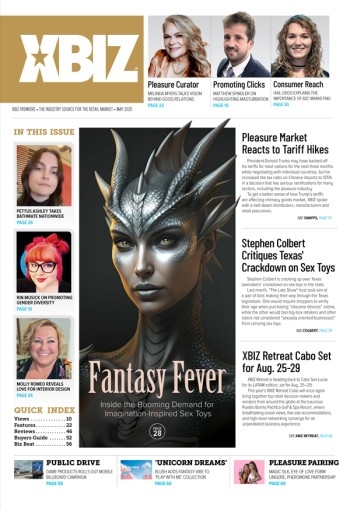When mobile first started to find its way onto the landscape of the adult online industry, some companies reacted quickly and profited greatly. Others were slower to move forward, while many seemed to stay stuck in an earlier era pretending that desktops would remain dominant forever. Now a secondary shift is starting to take place, and it seems many of those same market forces are at work once again.
For the many site owners who were late to catch on to the value of mobile traffic, we asked leaders in the space to scout out some important upcoming trends on the horizon that may help you to leapfrog forward and get back to the front of the line.
Now as the mobile market matures, other vital advantages like position in a region, early adoption in China, the fine-tuning aspects of carrier or device settings and more are making mobile about much more than the direct clicks you get from each ad buy or content play.
“Over the past two years we’ve seen a significant number of webmasters mobile optimize their website,” Kelan Stone, director of sales for Grand Slam Media, told XBIZ. “Not to mention how rare you’ll see mobile redirects on any larger sites as Google will punish the webmaster for doing so.
“We’re seeing mobile traffic increasing on a daily basis and it’s simply a result of more and more mobile devices being introduced to the users, giving them the ability to surf this traffic with ease,” Stone said. “Advertisers on the other hand are doing more and more business with mobile traffic, strictly due to the fact that the targeting options (carriers, devices, geos, etc.) are increasing their odds of a return on their investment.”
It’s also worth noting that mobile traffic is not all the same.
As Oliver Crane, business development director of MobileCashout, told XBIZ, “mobile Wi-Fi traffic is very similar to desktop traffic as it uses the same payment method with credit card billing, however due to their screen size, smartphones are harder to convert with this payment method, and therefore the real traffic difference is the value of 3G traffic.”
“Prices vary from different geos. In Europe for example the U.K., France, Germany and Italy are the most expensive while there are additional differences with localized legislation dictating what carriers can put on their billing page. For example the U.K. allows a button that says PAY, whereas Italy allows a button that says ACCEPT. More consumers click accept as opposed to pay, which makes Italian carrier traffic more valuable and therefore more expensive.”
Differences in mobile traffic also come from the plethora of devices available to customers. There are dozens of popular handsets varying by region, and the tablet market, which is often lumped in together with smartphones by some novices, is actually another way to differentiate the audience you seek to monetize.
“There are differences between tablet and mobile phones,” Stone said. “In my opinion, tablet is still catching up to mobile phones strictly because there is much less tablet traffic out there and as a result there are less advertisers with time and resources going into it. Another significant setback with tablet traffic is that a majority of it is Wi-Fi, which again limits the numbers of advertisers and offers that can monetize the traffic. Like any ad zones; whether it’s desktop, mobile phones or tablet traffic, it comes down to aligning the right offers with the right traffic and using a number of targeting options to increase the chances of an ROI — hence why we released Adnium.com.”
So much continues to be discussed in mainstream media about the concept of wearables, from bracelets and watches to connected clothing apparel. However, no matter how much steam the media may pump into that market it still isn’t ripe in the minds of those who know the most.
“It’s early days yet with the wearables market, but there is certainly scope for innovation,” Peter Rabenseifner, head of business development for ExoClick, told XBIZ. “For example Tinder have an app for the Apple watch that monitors your heart beat when looking at matches and if your heart rate increases it automatically matches you with their profile.
“I think there is huge potential for localized dating and wearables, if you are a member of Ashley Madison, it could alert you when local hook ups you liked are in your area for example. I think that fine tuning the user experience specifically for wearable devices will be a key driver in traffic generation eventually.”
Other insiders remain lukewarm on wearables for good reason.
“I do not foresee the mobile wearables market developing into a unique niche for adult traffic in the near future,” Jenna Stortini, global sales executive for Grand Slam Media, told XBIZ. “In my opinion the iWatch was invented to reduce distractions — not increase them. Users enjoy streaming videos on larger screens and the history of iPhones proves this to be true.
“When Apple launched their first iPhone the screen was 3.5”, they have since increased the screen size three times; the latest iPhone features a 5.5” screen,” Stortini said. “Mobile advertising revenues have increased practically in lock step with the size of smartphones. In terms of advertisements on a mobile wearable, I see this as being a challenge due to the size restrictions of the iWatch (1.32”).
“This being said, companies adapt to user patterns and create new ways to communicate with consumers. New technology often passes through several stages of development, and because of this, I’m confident that people will come up with innovative ways to use this new technology to stimulate commerce.”
Beyond devices and carrier types, geographical regions continue to play a key role in the evolution of mobile. China for example has long been a sleeping giant for publishers and advertisers seeking to monetize content, but that too may be about to change and mobile is likely to be the best way to get in position for what could become a huge wave of new customers.
“China is on its way to becoming a dominant market for mobile traffic that media buyers can really take full advantage of soon,” Andrew Rapley, senior sales executive of Grand Slam Media, told XBIZ. “Every month the amount of advertisers and affiliates seeking this type of traffic has been increasing. China has an enormous amount of mobile users that use their mobile device as their primary source for Internet access, so it makes it a prime opportunity for marketers to capitalize on.”
Oliver Crane from MobileCashout agreed, “With 500 million smartphone users in China, it is the worlds’ No. 1 market. The main problem is the barrier for outside product owners to enter this market, you either need to partner with a Chinese-based company or open an office in China in order to monetize this market with product.”
There are starting to be some cracks in the wall Chinese authorities have erected, and marketers are beginning to exploit those cracks with some innovative methods.
“For adult publishers, China is a difficult market due to the restrictions in place. One way to get around this is to send adult traffic to non-adult offers,” explained Rabenseifner of ExoClick. “Companies could also look at cam formats but for different cultural niches — for example Bobo.com is a live Chinese cam site where you pay the models to sing to you, which is hugely popular.
“According to data from iResearch, in Q1 2015, China’s mobile shopping market had a total transaction value exceeding RMB 36.23 billion (U.S. $5.9 billion), which is a significant sum. Adult advertisers should look to push hard good offerings such as performance pills with Chinese herbs, or toys for example.”
Before going full force into mobile and attempting to take over the world across every continent and device, finding people you can trust to help you find your way is crucial.
“One of the most important aspects of the business that is often overlooked is relationships,” Rapley said. “The ability to have guidance from experts in the traffic business who have the knowledge and expertise about the current climate, top sources of traffic, what’s working and where — all helps you maximize your return on investment and give you the best bang for your buck. With one point of contact handling all of your ad buys, there’s less hassle for you, and you can focus on optimizing and scaling up your campaigns.”
In some cases those relationships can have very direct benefits.
Rabenseifner explained, “ExoClick’s global strategic partnership network has enabled us to gain direct access to mobile carrier IP addresses in Europe, North America, South America, Africa, Asia and Australia to provide worldwide carrier targeting. Most ad networks will either let you buy carrier traffic or carrier traffic mixed with Wi-Fi, because of our partnerships ExoClick allows advertisers to also purchase Wi-Fi only traffic. If you are specialized in Wi-Fi offerings, why waste your money on expensive carrier traffic mixed with cheaper Wi-Fi traffic?”
“Our option enables Wi-Fi advertisers to spend their budgets wisely. ExoClick also offers specific ad formats for mobile including popunders, display banners, mobile redirects and instant messages as well as our own in app Android SDK, which places a sticky banner within android apps. We offer real time statistics to track the performance of your campaigns. Mobile traffic is expensive so in order to maximize your ROI you really need to know what you are doing, by providing these real time tools we offer our clients the intelligence they need.”
MobileCashout’s Crane pointed out there are also localization benefits of having the right strategic partners.
“MobileCashout offers global coverage with precise localized knowledge and our products cover 30 countries around the world with carrier billing, and over 100 more with credit card solutions,” Crane said. “Therefore we can offer both global and local advice to clients on how to best monetize different GEOs. Additionally, our platform automatically sends alerts to clients when they receive a conversion so they can track their revenues in real time.”
During the dawn of mobile, it was all about getting clicks and turning them into cash.
Now as the mobile market matures, other vital advantages like position in a region, early adoption in China, the fine-tuning aspects of carrier or device settings and more are making mobile about much more than the direct clicks you get from each ad buy or content play.
It isn’t too late to get into mobile, but the window is closing and those who get stuck outside this time may be even more disenfranchised than they were during the first wave of mobile evolution.






